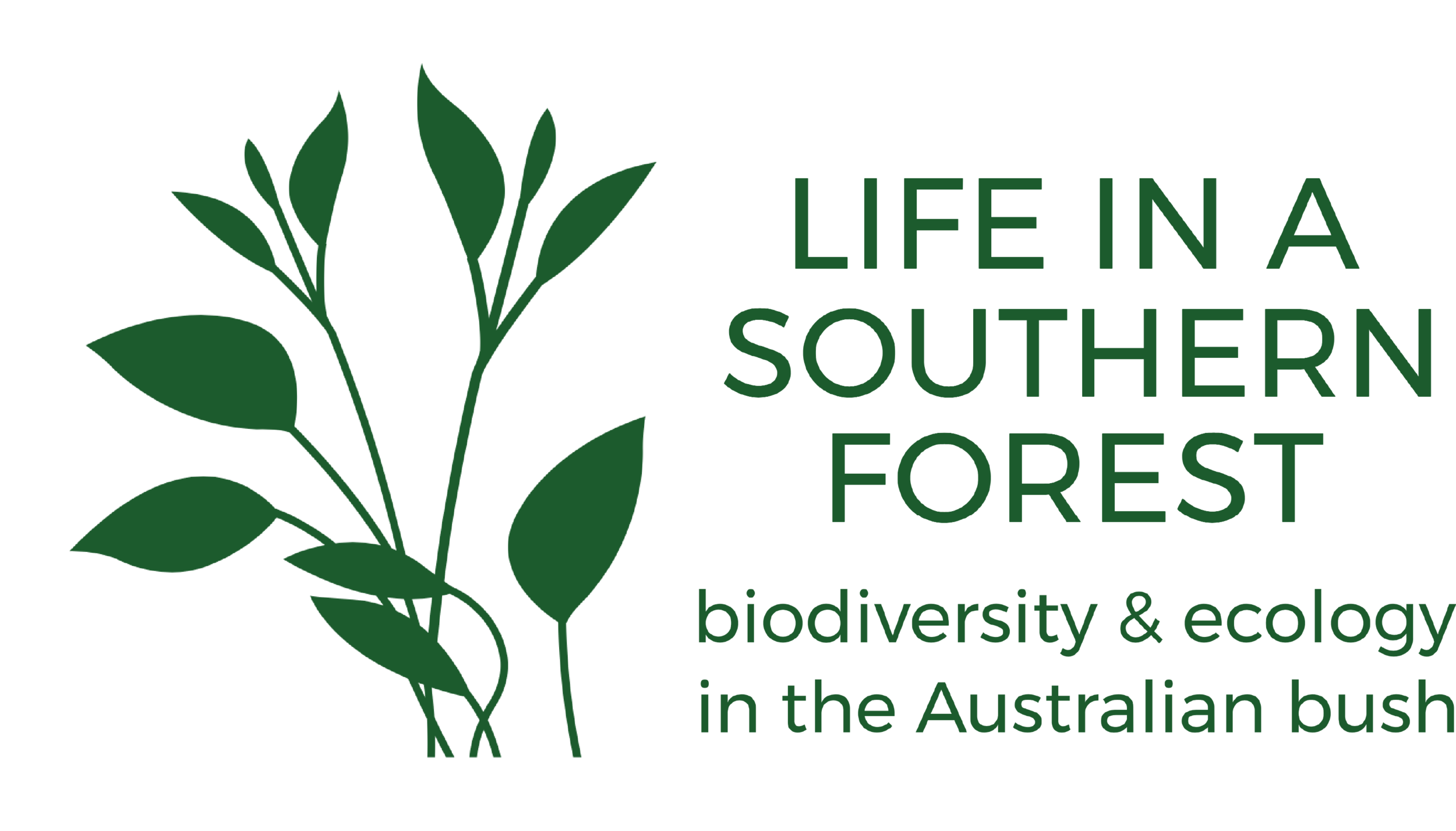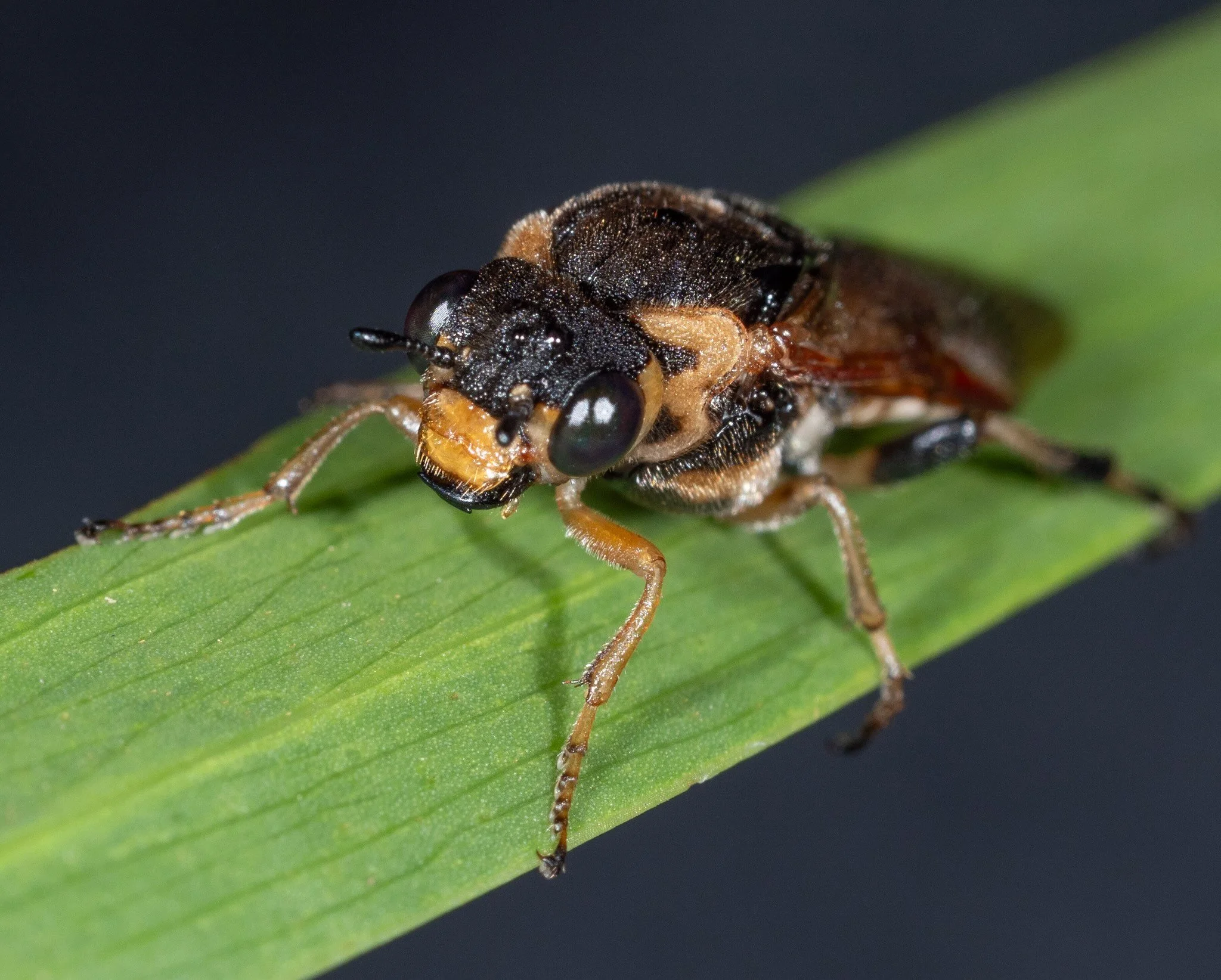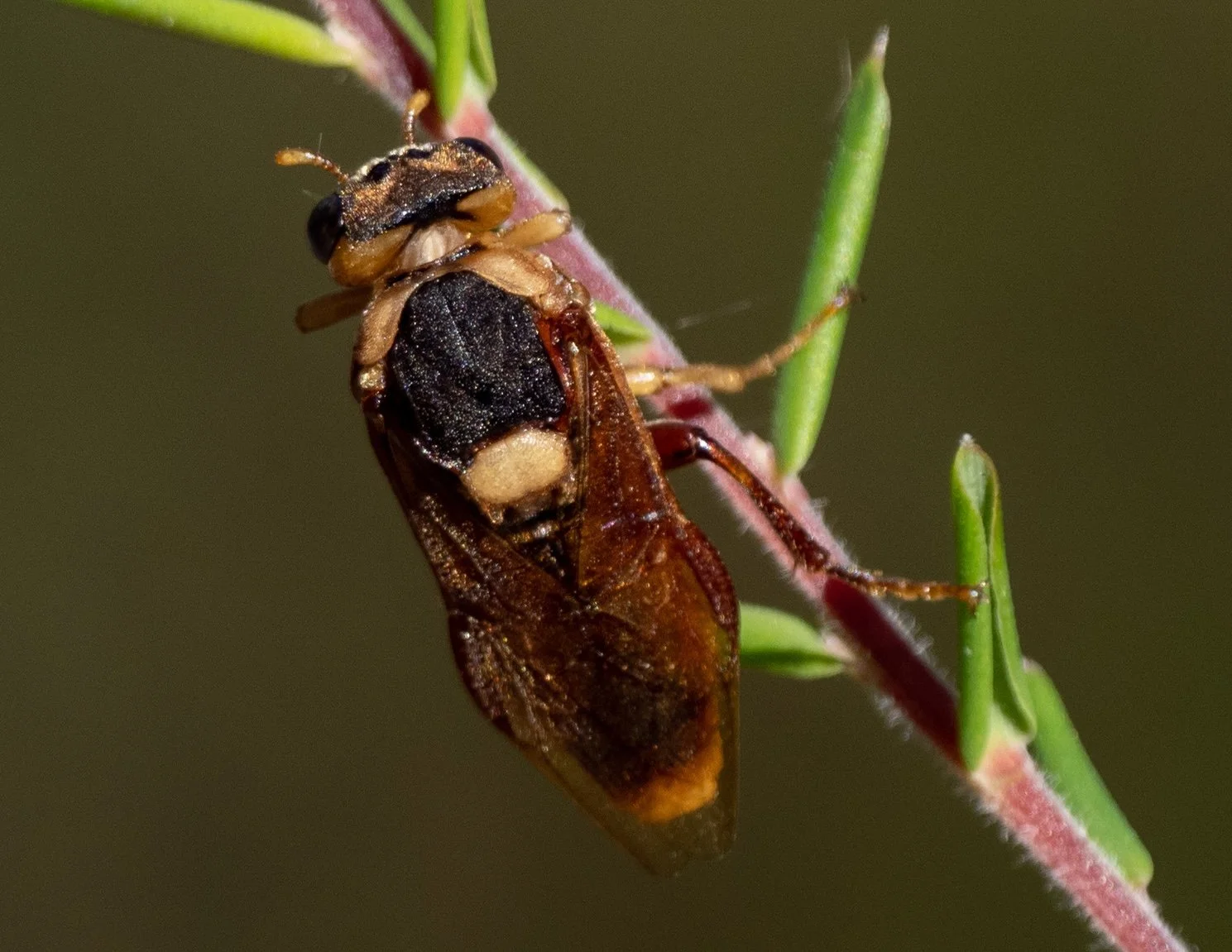Pseudoperga guerinii (PERGINAE) PW042

Workbook
Male Pseudoperga guerinii (#PW042) found on 11/4/2025 clutching an Acacia leaf.
Photo gallery of the living insect shown below, together with drawing from original description by Westwood (1880)
High resolution images of euthanised #PW042.
Dorsal view
Lateral view
Ventral view
Ventral view
Wings - dorsal view, fore wing on top
Wings - ventral view, hind wing on top
Frontal view
Translation of original Latin description by Westwood (1880)
Male.
- antennae completely black, each mounted on a small yellow tubercle
- head black, yellow lateral and beneath the eye, whole clypeus and labrum yellow, black mandible
- pronotum yellow laterally, with a black triangular spot in the middle
- dorsal thorax black and rough with border of the prosternum and two oblong spots beneath the wings yellow
- legs yellow with following parts black - apical half of hind femur, tibia and tarsomeres
- dorsal side of abdomen, steely black, shiny, final segment yellow; ventral side yellow;
- wings pale brown, forewings with thickened costa and stigma dark brown; first submarginal cell absent, fused in callus between costa and stigma; stigma obliquely truncated and narrowed on the margin of the forewings.
Conclusion: My specimen PW042 is a close match to the original description of Pseudoperga guerinii by Westwood (1880)
Specimen PW042 is a close match to other iNaturalist Pseudoperga guerinii observations
I have re-examined all 15 iNaturalist observations identified as male Pseudoperga guerinii by James Peake and myself. They are very similar to one another and my specimen PW042, as summarised in this spreadsheet. The only apparent difference between these is in the colour of the scutellum (either all black or black with variably sized yellow lateral areas) and the degree of infuscation of the legs. The latter is a variable feature in many sawfly species.
One of these iNat observations was made at Mt. Buller by James Peake when many female P. guerinii were laying eggs and guarding larvae on the Eucalyptus pauciflora vegetation. James comments that no other Pseudoperga species were seen there at that time, supporting the conclusion that this male is indeed Pseudoperga guerinii.
DNA barcoding calls into question the identity of PW042 as Pseudoperga guerinii
Right hind leg of specimen PW042 was removed for DNA barcoding by Erinn Fagan-Jeffries. DNA extracted and the COI gene sequenced, sequence shown below.
AACCCTATATTTTATTTTTGGAGTATGATCTGGTATAATTGGTCTATCATTTAGAATAATTATCCGAACAGAAATAATAACCACAGGATCATTTATTGGAGATGACCAAATTTATAACGTAATTGTAACATCCCATGCATTCCTAATAATTTTTTTTATAGTTATACCGATTATAATAGGAGGATTTGGAAACTGACTTCTACCCCTTATACTAGGGGCCCCTGATATAGCATTCCCCCGACTTAATAATTTAAGATTTTGACTATTACCCCCATCTTTAATCCTACTAACATTCAGAAGATTTATTAATTCAGGGTCAGGAACAGGATGAACAGTGTATCCCCCCCTATCGAGTAATATTGCTCATGCTGGAGCATCAGTAGATATAACTATCTTTTCTCTTCATATAGCTGGAATCTCATCAATTTTAGGGGCTATTAATTTTGTTTCAACAGTTATTAACATACGAGCCTCAGAAATAAGATTAGATAAAATACCCTTATTAGTGTGAGCTGTCACTATCACTGCAATTTTATTAATCATTTCTCTCCCTGTACTAGCAGGTGCTATCACCATATTATTAACAGATCGAAACCTAAATACATCATTCTTTGACCCATCAGGCGGAGGAGACCCTATCTTATACCAACACTTATTC
This sequence was compared to the COI gene from 4 specimens identified as female Pseudoperga guerinii on BOLD (SICOD116-19, SICOD117-19, AUSMG457-20, AUSMG458-20).
Photos of the first two of those BOLD specimens are shown below. These images accord with published descriptions of female P. guerinii and differ from the similar species P. lewisii. (A matrix comparing morphology of P. guerinii and P. lewisii as well as other Pseudoperga species is shown here).
Pair-wise comparisons using MUSCLE show that those 4 BOLD specimens of female P. guerinii have a level of similarity ranging from identical to 98.2% - shown here. This is often expressed as the converse - level of difference - in this case 0 to 1.8.
A pair-wise comparison reveals that the PW042 specimen is only between 87.9 to 88.9% similar to these BOLD P. guerinii specimens, i.e. level of difference 11.1 to 12.1.
This result suggests that the PW042 specimen is unlikely to be P. guerinii. Schmidt et al. (2017) report that the intraspecific sequence difference (ISD) in 8 of 9 species tested in the family Pergidae ranged from 0.15 to 1.39. The exception is Polyclonus atratus with an ISD of 3.27.
These values are much lower than the 11.1 to 12.1 range for comparison of PW042 and the BOLD P. guerinii specimens. Those figures are in the range reported by Schmidt et al. (2017) of 4.2 to 18.98 when comparing 21 Pergidae species with their closest different species (nearest neighbour, NN).
It is similar to the difference - 13.7 - between PW042 and BOLD Pergidae specimen HYAS1002-11 which James and I have identified as the male of another Pseudoperga species P. ferruginea. (The gallery below shows HYAS1002-11 and a P. ferruginea male).
There is a closer match - 2.4 difference - between PW042 and a BOLD specimen GBAH9416-14.COI-5P. identified as a Pseudoperga sp. tJ2.
Could PW042 be another Pseudoperga sp?
There are only 3 other Eastern Australian Pseudoperga species - P. belinda, P. ventralis and P. lucida. A comparison between these species and the PW042 specimen shows that none is as good a morphological match to the latter as the male P. guerinii.
Other possible explanations for mismatch between COI sequence and morphological identity of PW042
One possibility is that this mismatch is due to a PCR error. Sequencing of PW042 on the other hind leg of the specimen could provide a test of this possibility.
Another possibility is that PW042 is a cryptic species of Pseudoperga guerinii i.e. with same morphology but a different genotype. As noted above, there is variability in the colour of the scutellum - either all black or black with lateral cream stripes of variable width - in iNaturalist observations of male P. guerinii.
References:
Schmidt, S. et al. (2017) “Identification of sawflies and horntails (Hymenoptera, ‘Symphyta’) through DNA barcodes: successes and caveats.” Molecular Ecology Resources 17, 670-685.
Westwood, J.O. (1880) “A monograph of the sawflies composing the Australian genus Perga of Leach.” Proceedings of the Zoological Society of London 1880: 359-379, pls xxxiii-xxxvii.
This is a workbook page … a part of our website where we record the observations and references used in making species identifications. The notes will not necessarily be complete. They are a record for our own use, but we are happy to share this information with others.











